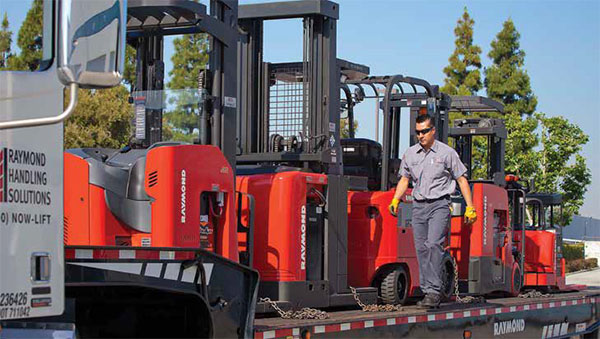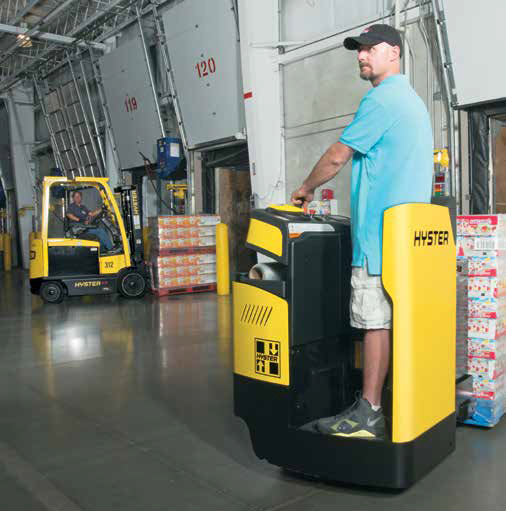Lift Trucking Financing: Funding Flexibility
Customers demand lease agreements that allow for change, reduce or eliminate penalties, and prevent surprises during or at the end of the term. Finance partners have responded by offering unprecedented flexibility and risk mitigation.
Latest Material Handling News
That is no longer the case, as dealers, manufacturers’ captive finance groups or other finance partners work with end-users to fine-tune equipment costs on a quarterly, monthly or as-needed basis—as opposed to 60-month intervals.
Rather than signing on the dotted line and hoping for the best in coming years, lift truck users are now able to use flexible leasing options like they would any other tool to control costs on an ongoing basis. This approach can yield savings in lease payments as well as meaningful improvements in equipment uptime and productivity.
“The ongoing management of agreements requires finance partners to be present and engaged with the customer to ensure everything is okay and fix what’s not,” says Bill Buckhout, director of leasing and remarketing, Yale Materials Handling Corp., who emphasizes that the customer also has a responsibility to engage. “The practice of just dropping off equipment and waiting until the end of the lease term is much too common and very problematic for costs, relationships and productivity. A customer who does that is making a huge mistake. There are plenty who are very busy, but for the most effective equipment program, they have to stay engaged. There is no fix-and-forget solution.”
Preparing for productivity
Lease structures are becoming more flexible throughout the term, but it remains critically important to do plenty of homework in advance of entering into an agreement. The process should begin with the assembly of a team of stakeholders.
“Purchasers and operations personnel, ideally, should be in open communication where procurement outlines their challenges and what they want to control in terms of upfront costs, and operations explains the impacts on their side,” says Eric Cleveland, financial services manager for Hyster Company. “We’ve seen this relationship evolve positively in light of telemetry and other tools they have to quantify and evaluate objectives. If they’re working hand in hand toward goals and have a plan in place throughout the lease and afterward, they will enjoy a successful partnership.”
Ultimately, disciplined collaboration can enable very precise cost management and performance benchmarking. Buckhout says that the conversation was historically about an asset’s cost per hour, but that is now just the beginning.
“If you move one pallet per hour, cost per hour doesn’t measure productivity,” says Buckhout. “If you drill deeper, you can identify the cost per unit of measure moved, whether that’s cost per pallet move or per pick. It’s much more granular, and metrics today measure productivity.”
Whether or not advanced telematics and data-mining are used, it’s essential that all stakeholders and finance partners have a comprehensive understanding of the application when structuring a lease. Buckhout says most customers do some rough math—two 8-hour shifts equals 16 hours of use per day—and end up buying too many hours.
“Others have been burnt by using equipment too much,” adds Buckhout. “Even annual or semiannual reviews should validate that the lease is on track. If you need more hours, renegotiate and buy more, don’t buy them up front. This will ensure the end-of-lease process is free from problems.”
Chris Craig, financial merchandising manager at Toyota Material Handling, U.S.A. emphasizes the importance of a thorough site survey prior to proposal. “Some applications are abusive to the point that they wouldn’t qualify at all for a residual lease,” he says. “Others might not qualify for the highest residual, but there’s a middle ground category that balances payments and residuals and includes less stringent language for the equipment’s off-lease condition.”
A thorough survey can prevent under- or over-estimation and produce other specifications and clauses that can be incorporated into the lease contract. Provisions might allow for early returns with no penalty if business slows in year one, or they might codify the anticipated plan for end-of-term equipment purchases.
“It’s difficult to anticipate everything, but if you expect changes you might sign a shorter lease with options to extend,” says Eric Gabriel, senior manager of marketing and sales support at Mitsubishi Caterpillar Forklift America. “A 60-month lease will offer the lowest payment, but a 36-month lease will grant added flexibility.”
Regardless of the lease term, Brian Markison, director of North American sales for UniCarriers, recommends every lease negotiation include a 12-month extension option. “If you have the ability to exercise that option, customers can make a decision at the end of the term if the lift truck is still solid,” Markison says, “and payments in that extended period will be lower than the base lease.”
For leases bundled with maintenance programs, Buckhout advises detailed negotiation in advance of signing. “‘Maintenance agreement’ is not a coverall term,” he says. “You can get something that covers everything–including abuse–or nothing but oil changes. If you use a lot of tires you might want to include them as covered expense. If you use few, take them out of the agreement for those savings.”

Leases ensure proper equipment replacement cycles, but might also allow for changes in fleet composition throughout the term.
Flexible financing
As soon as the lease is finalized and the equipment is at work, changes will come. Data might reveal a reach truck’s usage involves more travel than lifting and that a pallet truck is more appropriate to the application.
Alternatively, a lift truck might need greater height to optimally access storage locations. More commonly, a heavily used piece of equipment should be swapped with a lift truck with lower hours to ensure balanced fleet utilization and avoid end-of-term overages. Jeff Bailey, director of Crown Credit Company, says that the wide range of potential adjustments to fleet composition is driving significant change in how finance partners deliver services.
“It’s forcing the leasing industry to adapt to those changes, which encourages customers to lease because it now allows them to do things they couldn’t do in the past,” Bailey says. “They’re pushing the risk to the leasing company since they don’t always know what their business or the economy will do. They need an out that’s not going to punish them if they need a different model or fewer lift trucks. Most captive lease companies are starting to play ball with that.”
In cases of extreme seasonality, a lease might be structured around quarterly or seasonal payment schedules, or skip invoices during months of particularly low utilization. Data might also suggest a low-use application is better served by a pre-owned or refurbished lift truck.
Tim Combs, president of sales and marketing for The Raymond Corporation, says leases are no longer associated only with new equipment, which can be particularly beneficial to medium and small businesses.
“Sometimes it seems that leasing alternatives are more appealing to smaller or mid-sized businesses, but the same advantages apply to big fleets, and we’ve seen greater interest in larger accounts than in the past,” Combs says. “At the end of the term we take back the equipment and dispose of it in the best way possible for each unit.”
For those who purchase equipment, Combs says there is a hesitancy sometimes to get rid of it until it is “dead.” Aging equipment becomes more expensive to keep, and even if the customer recognizes a lift truck’s economic life is over it’s not always easy to dispose of.
“When their only choice is to scrap, it’s a matter of meeting environment guidelines for proper disposal,” Combs adds. “Generally speaking, when a customer scraps a lift truck, the very best they can hope for is the scrap value will cover disposal costs—but it usually doesn’t.”
Equipment that is returned at the end of the term with some economic life remaining can be remarketed, Bailey says, which allows the supplier to make use of each unit in an ideal application.
“Before, if we received equipment with a high residual value, we couldn’t easily sell it at a dollar amount that matched our investment, but now we could put it into a rental fleet or provide it directly to another user,” says Bailey. “That’s a barrier that used to be big, but we can now spread those costs and assets around by matching each piece of equipment with the specific application needs of each customer.”

A thorough application survey is essential to an effective union of lease terms, equipment specification, productivity and costs.
Reporting results
As keen as lift truck users might be to focus on core competencies and offload fleet management, they must remain engaged with dealers, service providers and finance partners. Markison says this need not be an elaborate exercise, and that periodic 30-minute reviews can help tremendously.
“There’s still a feeling that some don’t have the time, since the forklift is only there to support the primary business,” he says. “But you never want to neglect any input on cost structure. Management priorities are different from facility to facility, and the very good ones are more than excited to sit down and review fleet costs. The ones that really need the help tend to be a little out of control anyway and don’t want to meet because they have other fish to fry.”
A close relationship can help ensure customers and dealers are aware of the condition and hour meters of leased equipment. Dealers can also communicate damage issues so the customer can plan accordingly and work to mitigate both the cause of damage and the related costs.
At the very least, the dealer can make a customer aware of damage charges, but they can also work to find creative ways to deal with those charges, according to Toyota’s Craig. For example, a dealer might build damage costs into the existing lease, or the agreement for replacement equipment. Leases bundled with full maintenance programs can further reduce costs while protecting the customer from risk.
“Some finance companies offer higher residuals for equipment leased with a full maintenance agreement, which can lower the lease rate by 10% or more,” Craig says. “One advantage of a full maintenance program is that the customer is assured the equipment is maintained properly, which increases uptime.”
Even if the lease structure and real-world utilization match up nicely throughout the term, many customers still struggle to make timely decisions at the end of the lease. As a result, they often end up in costly month-to-month renewals for equipment that should be replaced. Craig says lease customers should receive a notification six months before the end of the term, at which time planning can begin.

Article Topics
Magazine Archive News & Resources
Latest in Materials Handling
ASME Foundation wins grant for technical workforce development The (Not So) Secret Weapons: How Key Cabinets and Asset Management Lockers Are Changing Supply Chain Operations MODEX C-Suite Interview with Harold Vanasse: The perfect blend of automation and sustainability Consultant and industry leader John M. Hill passes on at age 86 Registration open for Pack Expo International 2024 Walmart chooses Swisslog AS/RS and software for third milk processing facility NetLogistik partners with Vuzix subsidiary Moviynt to offer mobility solutions for warehouses More Materials HandlingAbout the Author
Subscribe to Materials Handling Magazine

Find out what the world's most innovative companies are doing to improve productivity in their plants and distribution centers.
Start your FREE subscription today.
April 2024 Modern Materials Handling

Latest Resources










